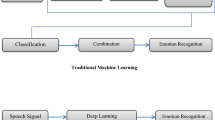Abstract
In this paper different kinds of emotional speech corpora are compared in terms of speech acquisition (acted speech vs. elicited speech), utterance length and similarity to spontaneous speech. Feature selection is applied to find an optimal feature set and to examine the correlation of different kinds of features to dimensions in the emotional space. The influence of different feature sets is evaluated. To cope with environmental conditions and to get a robust application, effects related to energy and additive noise are analyzed.
Preview
Unable to display preview. Download preview PDF.
Similar content being viewed by others
References
Douglas-Cowie, E., Cowie, R., Schröder, M.: A new emotion database: Considerations, sources and scope. In: Proc. ISCA Workshop on Speech and Emotion (2000)
Devillers, L., Vasilescu, I.: Prosodic cues for emotion characterization in real-life spoken dialogs. In: Proc. Eurospeech, Geneva (2003)
Lee, C.M., Narayanan, S.: Emotion recognition using a data-driven fuzzy interference system. In: Proc. Eurospeech, Geneva (2003)
Gustafson-Capková, S.: Emotions in speech: Tagset and acoustic correlates (2001)
Oudeyer, P.Y.: Novel useful features and algorithms for the recognition of emotions in human speech. In: Proc. 1st International Conference on Prosody (2002)
Seppänen, T., Väyrynen, E., Toivanen, J.: Prosody-based classification of emotions in spoken finnish. In: Proc. Eurospeech, Geneva (2003)
Hozjan, V., Kačič, Z.: Improved emotion recognition with large set of statistical features. In: Proc. Eurospeech, Geneva (2003)
Mozziconacci, S.J.L., Hermes, D.J.: Role of intonation patterns in conveying emotions in speech. In: Proc. ICPhS, San Francisco (1999)
McGilloway, S., Cowie, R., Douglas-Cowie, E., Gielen, S., Westerdijk, M., Stroeve, S.: Approaching automatic recognition of emotion from voice: a rough benchmark. In: Proc. of the ISCA workshop on Speech and emotion, Newcastle (2000)
Rahurka, M.A., Hansen, J.H.L.: Frequency distribution based weighted sub-band approach for classification of emotional/stressful content in speech. In: Proc. Eurospeech, Geneva (2003)
Batliner, A., Fischer, K., Huber, R., Spilker, J., Nöth, E.: Desperately seeking emotions or: Actors, wizards, and human beings. In: Proc. ISCA Workshop on Speech and Emotion, Belfast (2000)
Osgood, C.E., Suci, G.J., Tannenbaum, P.H.: The Measurement of Meaning. University of Illinois Press, Urbana (1967)
Tato, R., Santos, R., Kompe, R., Pardo, J.: Emotional space improves emotion recognition. In: Proc. ICSLP (2000)
Santos, R.: Emotion recognition in speech signal. Master’s thesis, Technical University of Madrid (2002), http://www-gth.die.upm.es/partners/sony/main.html
Schölkopf, B., Smola, A.J.: Learning with Kernels. MIT Press, Cambridge (2002)
Meyer, Schützwohl, Reisenzein: Einführung in die Emotionspsychologie. Huber, Göttingen (1999–2003)
Amir, N.: Classifying emotions in speech: A comparison of methods. In: Proc. of Eurospeech (2001)
Duda, R.O., Hart, P.E., Stork, D.G.: Pattern Classification, 2nd edn. Wiley, Chichester (2001)
Lawrence, C., Rahim, M.: Integrated bias removal techniques for robust speech recognition. Computer Speech and Language 13, 283–298 (1999)
Matassoni, M., Omologo, M., Svaizer, P.: Use of real and contaminated speech for training of a hands-free in-car speech recognizer. In: Proc. Eurospeech, Aalborg, Denmark (2001)
Giuliani, D., Matassoni, M., Omologo, M., Svaizer, P.: Training of HMM with filtered speech material for hands-free recognition. In: Proc. ICASSP, Phoenix, USA (1999)
Author information
Authors and Affiliations
Editor information
Editors and Affiliations
Rights and permissions
Copyright information
© 2004 Springer-Verlag Berlin Heidelberg
About this paper
Cite this paper
Küstner, D., Tato, R., Kemp, T., Meffert, B. (2004). Towards Real Life Applications in Emotion Recognition. In: André, E., Dybkjær, L., Minker, W., Heisterkamp, P. (eds) Affective Dialogue Systems. ADS 2004. Lecture Notes in Computer Science(), vol 3068. Springer, Berlin, Heidelberg. https://doi.org/10.1007/978-3-540-24842-2_3
Download citation
DOI: https://doi.org/10.1007/978-3-540-24842-2_3
Publisher Name: Springer, Berlin, Heidelberg
Print ISBN: 978-3-540-22143-2
Online ISBN: 978-3-540-24842-2
eBook Packages: Springer Book Archive




